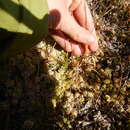en
names in breadcrumbs


Luzula wahlenbergii, commonly known as Wahlenberg's woodrush or reindeer wood-rush,[2] is a perennial species of plant in the genus Luzula of the (rush) family Juncaceae.[1]
Luzula wahlenbergii is in the section Diprophyllatae of the genus Luzula of the (rush) family Juncaceae.[3] L. wahlenbergii was first formally described by the Austro-Russian botanist Franz Josef Ruprecht in 1845.[1]
With regards to the etymology of the binomial: the generic name Luzula could come from the Italian lucciola ("to shine, sparkle") or the Latin luzulae or luxulae, from lux ("light"), inspired by the way the plant's hairs sparkle when wet with dew.[4] Another etymology sometimes given is that it does derive from lucciola but that this meant a midsummerfield, or from the Latin luculus, meaning a small place; the same source also states that this name was applied by Luigi Anguillara (an Italian botanist) in 1561.[5] The second part of the binomial, wahlenbergii is in tribute to the Swedish botanist Göran Wahlenberg, who studied the flora of the northernmost areas of Sweden.[2]
Luzula wahlenbergii is herbaceous perennial plant that grows in loose tufts to a height of around 15–35 cm (5.9–13.8 in).[1][6] It is almost hairless. Its leaves have very small serrations at the edges and taper to a point. Leaves at the base of the stem are 5–10 cm (2.0–3.9 in) long by 3–5 mm (0.12–0.20 in) wide. There may be one or two leaves higher up the stem, 3–5 cm (1.2–2.0 in) by 2–4 mm (0.079–0.157 in).[1]
The plant's inflorescence has been described by eMonocot as a "lax nodding panicle". Measuring 4 cm × 3 cm (1.6 in × 1.2 in), it bears 10–30 flowers, with between one and three to a stem. The lower bracts are 4–10 mm (0.16–0.39 in) long, and there are shorter bracteoles and brown, pointed tepals. Each flower has six stamens. Pointed brown ellipsoidal seed capsules up to 2.4 mm (0.094 in) in length hold the dark chestnut-brown ellipsoidal seeds.[1]
Luzula wahlenbergii has a relatively wide distribution, growing across Arctic Eurasia, far-east Russia (including Transbaikal), Alaska, Greenland, Canada and the mountains of Scandinavia.[1]
Luzula wahlenbergii is an arctic-alpine plant,[1] and grows in mainly moist habitats. These include, but are not limited to, wet grasslands, mossy tundra,[1] the shores of lakes, alluvial rivers, gneissic seashore and alpine creeks.[7]
{{cite web}}: CS1 maint: uses authors parameter (link) Luzula wahlenbergii, commonly known as Wahlenberg's woodrush or reindeer wood-rush, is a perennial species of plant in the genus Luzula of the (rush) family Juncaceae.
Tunturipiippo (Luzula wahlenbergii) on vihviläkasvien (Juncaceae) heimoon ja piippojen (Luzula) sukuun kuuluva monivuotinen kasvilaji. Tunturipiippo muistuttaa röyhypiippoa (Luzula parviflora), mutta lajit ovat erotettavissa toisistaan kasvin koon sekä lehtien ulkonäön perusteella.[2]
Tunturipiippo voi kasvaa noin 30 cm korkeaksi ja on kasvutavaltaan mätästävä. Varsien tyvilehdet ovat 3–5 mm leveitä ja kaljuja, mutta nuorien lehtien reunat ovat kuitenkin harvakarvaiset. Varsissa on vain yksi tai kaksi varsilehteä, jotka ovat neulamaisia ja kaljuja. Tunturipiipon kukat sijaitsevat varren päässä terttua muistuttavana rykelmänä, ja kukinnon tukilehti on karvareunainen.[2]
Tunturipiippo kasvaa tunturien rinteillä, yleensä kosteilla kasvupaikoilla[2]. Suomessa tunturipiippoa tavataan lähes pelkästään Kilpisjärven seudulla, mutta monia vanhoja sekä muutamia uudempiakin havaintoja on myös Utsjoen ja Inarin alueilta[3].
Tunturipiipon tieteellisen nimen lajinimi (wahlenbergii) viittaa ruotsalaiseen kasvitieteilijään ja professoriin Göran Wahlenbergiin.[2]
Tunturipiippo (Luzula wahlenbergii) on vihviläkasvien (Juncaceae) heimoon ja piippojen (Luzula) sukuun kuuluva monivuotinen kasvilaji. Tunturipiippo muistuttaa röyhypiippoa (Luzula parviflora), mutta lajit ovat erotettavissa toisistaan kasvin koon sekä lehtien ulkonäön perusteella.
Tunturipiippo voi kasvaa noin 30 cm korkeaksi ja on kasvutavaltaan mätästävä. Varsien tyvilehdet ovat 3–5 mm leveitä ja kaljuja, mutta nuorien lehtien reunat ovat kuitenkin harvakarvaiset. Varsissa on vain yksi tai kaksi varsilehteä, jotka ovat neulamaisia ja kaljuja. Tunturipiipon kukat sijaitsevat varren päässä terttua muistuttavana rykelmänä, ja kukinnon tukilehti on karvareunainen.
Tunturipiippo kasvaa tunturien rinteillä, yleensä kosteilla kasvupaikoilla. Suomessa tunturipiippoa tavataan lähes pelkästään Kilpisjärven seudulla, mutta monia vanhoja sekä muutamia uudempiakin havaintoja on myös Utsjoen ja Inarin alueilta.
Tunturipiipon tieteellisen nimen lajinimi (wahlenbergii) viittaa ruotsalaiseen kasvitieteilijään ja professoriin Göran Wahlenbergiin.
Luzula wahlenbergii est une espèce de plantes herbacées de la famille des Juncaceae.
Selon Tropicos (24 mars 2014)[2] (Attention liste brute contenant possiblement des synonymes) :
Luzula wahlenbergii est une espèce de plantes herbacées de la famille des Juncaceae.
Це багаторічні зелені трав'янисті рослини, які утворюють купини або невеликі килими, за допомогою горизонтальних, розгалужених кореневищ з короткими гілками. Стебла 15–30 (35) см. Листя: піхви під гострим кутом; пластини базальних листків 5–10 см x 3–8 мм, верхівки коротко загострені, в основному голі; стеблові листки до 3–5 см x 2–4 мм. Суцвіття — нещільні похилі волоті, де квіти розміщені окремо чи в 2(3)-квіткових кластерах. Проксимальний приквіток 1 см або менше; приквітки коричневі; краї з довгими в'юнкими віями. Квітки поодинокі на коротких квітконіжках; квіткові листочки темно-пурпурно-коричневі, 2–2.5 мм, краї тонко розриваються до вершини, вершини гострі, не відігнуті; пиляки приблизно рівної довжини. Капсули темно-коричневі, менше 2.5 мм, трохи довші за квіткові листки. Насіння темно-червонувато-коричневе, циліндричне, 1.2–1.6 мм. 2n = 24.
Статеве розмноження насінням; місцеве вегетативне розмноження фрагментаціями колоній. Вид вітрозапильний. Насіння не мають адаптації до будь-якого особливого способу розсіювання і, ймовірно, поширюються на деяку відстань за вітром. Деяке розповсюдження птахами можливе.
Це арктичного-альпійський вид, однак у Ґренландії відомий тільки з одного місця зростання на північному сході. Вид досить поширений в північній Фенноскандії (Фінляндія, Норвегія, Швеція) та арктичній Росії, зростає в Японії, Канаді, Алясці. На архіпелазі Шпіцберген не широко розповсюджений.
Населяє вологі мохові арктичну й альпійську тундри, береги озер, намивні місця рік, береги гірських струмків, гнейсові узбережжя.
Luzula wahlenbergii là một loài thực vật có hoa trong họ Juncaceae. Loài này được Rupr. mô tả khoa học đầu tiên năm 1845.[2]
Luzula wahlenbergii là một loài thực vật có hoa trong họ Juncaceae. Loài này được Rupr. mô tả khoa học đầu tiên năm 1845.
云间地杨梅(学名:Luzula wahlenbergii)为灯心草科地杨梅属下的一个种。
|access-date=中的日期值 (帮助)